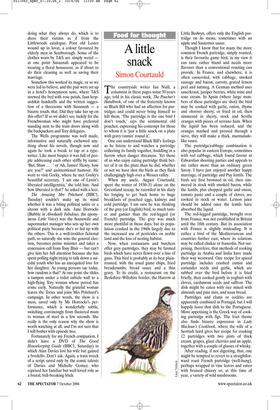A little snack
Simon Courtauld
The countryside writer Ian Niall, a columnist in these pages some 50 years ago, told in his classic work, The Poacher’s Handbook, of one of the fraternity known as Black Bill who had an affection for partridges and could never bring himself to kill them. ‘The partridge is the one bird I don’t touch,’ says the sentimental old poacher, expressing his contempt for those to whom it is ‘just a little snack on a plate with gravy runnin’ round it’.
One can understand Black Bill’s feelings as he listens to and watches a partridge collecting its family together, huddling in a furrow when danger threatens. Yet those of us who enjoy eating partridge think better of it on the plate than he did, whether or not we have shot the birds as they flash challengingly high over a Wessex valley.
When my uncle, August Courtauld, spent the winter of 1930–31 alone on the Greenland icecap, he recorded in his diary his longing to get back home to huge breakfasts of poached eggs, kidneys and cold partridge. I am sure he was thinking of the grey (or English) bird, so much tastier and gamier than the red-legged (or French) partridge. The grey was much more plentiful in those days, but its population crashed in the 1960s largely due to the increased use of pesticides on arable land and the loss of nesting habitat.
Now, when restaurants and butchers offer grey partridges, they may be farmed birds which have never flown over a line of guns. This bird is probably at its best plainroasted, with the usual game chips, fried breadcrumbs, bread sauce and a thin gravy. To its credit, a restaurant on the Berkshire–Wiltshire border, the Harrow at Little Bedwyn, offers only the English partridge on its menu, sometimes with an apple and Sauternes sauce.
Though I know that for many the more common French partridge, simply roasted, is their favourite game bird, in my view it can taste rather bland and needs more flavours than a conventional roasting can provide. In France, and elsewhere, it is often casseroled, with cabbage, smoked sausage and bacon, carrots, grated lemon peel and nutmeg. A German method uses sauerkraut, juniper berries, white wine and sour cream. In Spain (where large numbers of these partridges are shot) the bird may be cooked with garlic, onion, thyme and oloroso sherry, or fried in oil, then simmered in sherry, stock and Seville oranges with pieces of serrano ham. When the liquid has been reduced, and the oranges mashed and pressed through a sieve, they will make a thick, marmaladelike sauce.
The partridge/cabbage combination is also popular in eastern Europe, sometimes with red cabbage, which found favour at Edwardian shooting parties and appeals to me rather more than an ordinary green Savoy. I have just enjoyed another happy marriage, of partridge and Puy lentils. The birds are first browned in oil, then simmered in stock with smoked bacon, while the lentils, plus chopped garlic and onion, tomato paste and a couple of cloves, are cooked in stock or water. Lemon juice should be added once the lentils have absorbed the liquid.
The red-legged partridge, brought over from France, was not established in Britain until the 18th century. But its association with France is slightly misleading. It is rather a bird of the Mediterranean and countries further east, where its relations may be called chukar or francolin. Not surprising, therefore, that methods of cooking partridge in Arabia and India have made their way westward. One recipe for spiced partridge includes crushed cumin and coriander seeds and garlic, which are rubbed over the bird before it is fried briefly, then cooked gently in yoghurt with cloves, cardamom seeds and saffron. The dish might be eaten with rice mixed with almonds and pine nuts, and naan bread.
Partridges and clams or cockles are apparently combined in Portugal, but I will happily leave that dish to the Portuguese. More appetising is the Greek way of cooking partridge with figs. The fruit theme also finds bizarre expression in Lady Maclean’s Cookbook, where the wife of a Scottish laird gives her recipe for cooking 12 partridges with two pints of thick cream, grapes, glacé cherries and an apple, together with a couple of glasses of whisky.
After reading, if not digesting, that, one might be tempted to revert to a straightforward roast French partridge (well-hung), perhaps wrapped in vine leaves and eaten with braised chicory or, at this time of year, a variety of wild mushrooms.


















































































 Previous page
Previous page